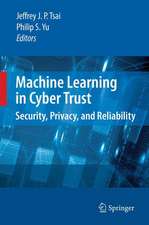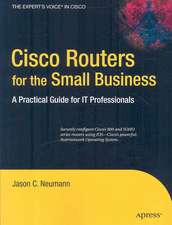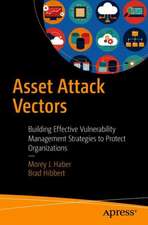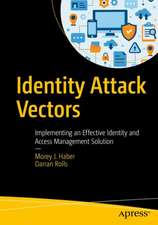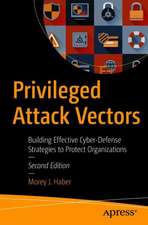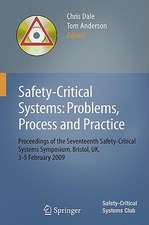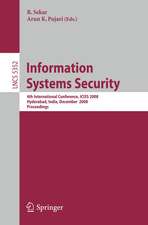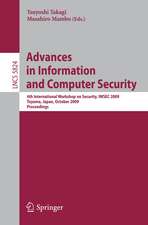Cloud Attack Vectors: Building Effective Cyber-Defense Strategies to Protect Cloud Resources
Autor Morey J. Haber, Brian Chappell, Christopher Hillsen Limba Engleză Paperback – 22 iul 2022
New, innovative, and useful products continue to emerge and offer some cloud protection, but they also have distinct limitations. No single, standalone solution or strategy can effectively protect against all cloud attack vectors or identify all malicious activity. The simple fact is that the cloud is based on a company’s assets being offered as services. As a result, the best security any organization can achieve is to establish controls and procedures in conjunction with services that are licensed in the cloud.
Cloud Attack Vectors details the risks associated with cloud deployments, the techniques threat actors leverage, the empirically-tested defensive measures organizations should adopt, and shows how to improve detection of malicious activity.
What You’ll Learn
- Know the key definitions pertaining to cloud technologies, threats, and cybersecurity solutions
- Understand how entitlements, permissions, rights, identities, accounts, credentials, and exploits can be leveraged to breach a cloud environment
- Implement defensive and monitoring strategies to mitigate cloud threats, including those unique to cloud and hybrid cloud environments
- Develop a comprehensive model for documenting risk, compliance, and reporting based on your cloud implementation
New security professionals, entry-level cloud security engineers, managers embarking on digital transformation, and auditors looking to understand security and compliance risks associated with the cloud
Preț: 312.68 lei
Preț vechi: 390.85 lei
-20% Nou
Puncte Express: 469
Preț estimativ în valută:
59.83€ • 63.98$ • 49.89£
59.83€ • 63.98$ • 49.89£
Carte disponibilă
Livrare economică 28 martie-11 aprilie
Preluare comenzi: 021 569.72.76
Specificații
ISBN-13: 9781484282359
ISBN-10: 1484282353
Pagini: 473
Ilustrații: XXXI, 473 p. 49 illus.
Dimensiuni: 155 x 235 mm
Greutate: 0.7 kg
Ediția:1st ed.
Editura: Apress
Colecția Apress
Locul publicării:Berkeley, CA, United States
ISBN-10: 1484282353
Pagini: 473
Ilustrații: XXXI, 473 p. 49 illus.
Dimensiuni: 155 x 235 mm
Greutate: 0.7 kg
Ediția:1st ed.
Editura: Apress
Colecția Apress
Locul publicării:Berkeley, CA, United States
Cuprins
Chapter 1. Introduction.- Chapter 2. Cloud Computing.- Chapter 3. Cloud Service Proviers.- Chapter 4. Cloud Definitions.- Chapter 5. Asset Manager.- Chapter 6. Attack Vectors.- Chapter 7. Mitigation Strategies.- Chapter 8. Regulatory Compliance.- Chapter 9. Architectures.- Chapter 10. Swarm Intelligence.- Chapter 11. Chaos Engineering.- Chapter 12: Imposter Syndrome.- Chapter 13: Selecting a Cloud Service Provider.- Chapter 14: Security Recommendations for your Cloud Environment.- Chapter 15: Conclusion.- Appendix A.- Appendix B.
Notă biografică
Morey J. Haber is Chief Technology Officer at BeyondTrust. He has more than 20 years of IT industry experience and is author of the book Privileged Attack Vectors and Asset Attack Vectors. Morey joined BeyondTrust in 2012 as a part of the eEye Digital Security acquisition. He currently oversees BeyondTrust technology for vulnerability, privileged, and remote access management solutions. In 2004, Morey joined eEye as the Director of Security Engineering and was responsible for strategic business discussions and vulnerability management architectures in Fortune 500 clients. Prior to eEye, he was a Development Manager for Computer Associates, Inc. (CA), responsible for new product beta cycles and named customer accounts. Morey began his career as a Reliability and Maintainability Engineer for a government contractor building flight and training simulators. He earned a Bachelors of Science in Electrical Engineering from the State University of New York at Stony Brook.Brian Chappell is Chief Security Strategist for Beyond Trust, EMEA & APAC, and is a multi-skilled individual with a passion for delivering best practice solutions that help customers run their businesses more effectively and securely. His specialties include: cybersecurity solutions, IT strategy and implementation, project management, global IT operations management, sales engineering, software development, and enterprise and solutions architecture.
Christopher Hills is a Security Strategist focused on Privileged Access Management (PAM) and Identity and Access Management (IAM). He is Security Strategist for BeyondTrust's Privileged Access Management Solutions, enforcing Privileged Password Management and Privileged Session Management, Privileged Endpoint Management, and Secure Remote Access which utilizes a single pane of glass for all management aspects, including Automated Account Discovery, Privileged Management and Elevation, Audit and Compliance, and Behavior & Reporting. His responsibilities include: IAM/PAM focus, strategy, mentoring, leadership, customer and prospect liaison, thought leadership, background reference, business development, customer-facing GRC, and working closely with global sales and marketing organizations to help support GTM efforts while assisting with critical sales opportunities and key marketing events.
Christopher Hills is a Security Strategist focused on Privileged Access Management (PAM) and Identity and Access Management (IAM). He is Security Strategist for BeyondTrust's Privileged Access Management Solutions, enforcing Privileged Password Management and Privileged Session Management, Privileged Endpoint Management, and Secure Remote Access which utilizes a single pane of glass for all management aspects, including Automated Account Discovery, Privileged Management and Elevation, Audit and Compliance, and Behavior & Reporting. His responsibilities include: IAM/PAM focus, strategy, mentoring, leadership, customer and prospect liaison, thought leadership, background reference, business development, customer-facing GRC, and working closely with global sales and marketing organizations to help support GTM efforts while assisting with critical sales opportunities and key marketing events.
Textul de pe ultima copertă
Cyberattacks continue to increase in volume and sophistication, targeting everything owned, managed, and serviced from the cloud. Today, there is widespread consensus—it is not a matter of if, but rather when an organization will be breached. Threat actors typically target the path of least resistance. With the accelerating adoption of cloud technologies and remote work, the path of least resistance is shifting in substantive ways. In recent years, attackers have realigned their efforts, focusing on remaining undetected, monetization after exploitation, and publicly shaming organizations after a breach.
New, innovative, and useful products continue to emerge and offer some cloud protection, but they also have distinct limitations. No single, standalone solution or strategy can effectively protect against all cloud attack vectors or identify all malicious activity. The simple fact is that the cloud is based on a company’s assets being offered as services. As a result, the best security any organization can achieve is to establish controls and procedures in conjunction with services that are licensed in the cloud.
Cloud Attack Vectors details the risks associated with cloud deployments, the techniques threat actors leverage, the empirically-tested defensive measures organizations should adopt, and shows how to improve detection of malicious activity.
What You’ll Learn
New, innovative, and useful products continue to emerge and offer some cloud protection, but they also have distinct limitations. No single, standalone solution or strategy can effectively protect against all cloud attack vectors or identify all malicious activity. The simple fact is that the cloud is based on a company’s assets being offered as services. As a result, the best security any organization can achieve is to establish controls and procedures in conjunction with services that are licensed in the cloud.
Cloud Attack Vectors details the risks associated with cloud deployments, the techniques threat actors leverage, the empirically-tested defensive measures organizations should adopt, and shows how to improve detection of malicious activity.
What You’ll Learn
- Know the key definitions pertaining to cloud technologies, threats, and cybersecurity solutions
- Understand how entitlements, permissions, rights, identities, accounts, credentials, and exploits can be leveraged to breach a cloud environment
- Implement defensive and monitoring strategies to mitigate cloud threats, including those unique to cloud and hybrid cloud environments
- Develop a comprehensive model for documenting risk, compliance, and reporting based on yourcloud implementation
Caracteristici
Presents real-world threats and risks facing cloud environments for businesses looking to embrace the cloud Covers the attack vectors used in cloud attacks, from misconfigurations to inappropriate entitlements Helps you understand the solutions and technology available to mitigate risks in the cloud


